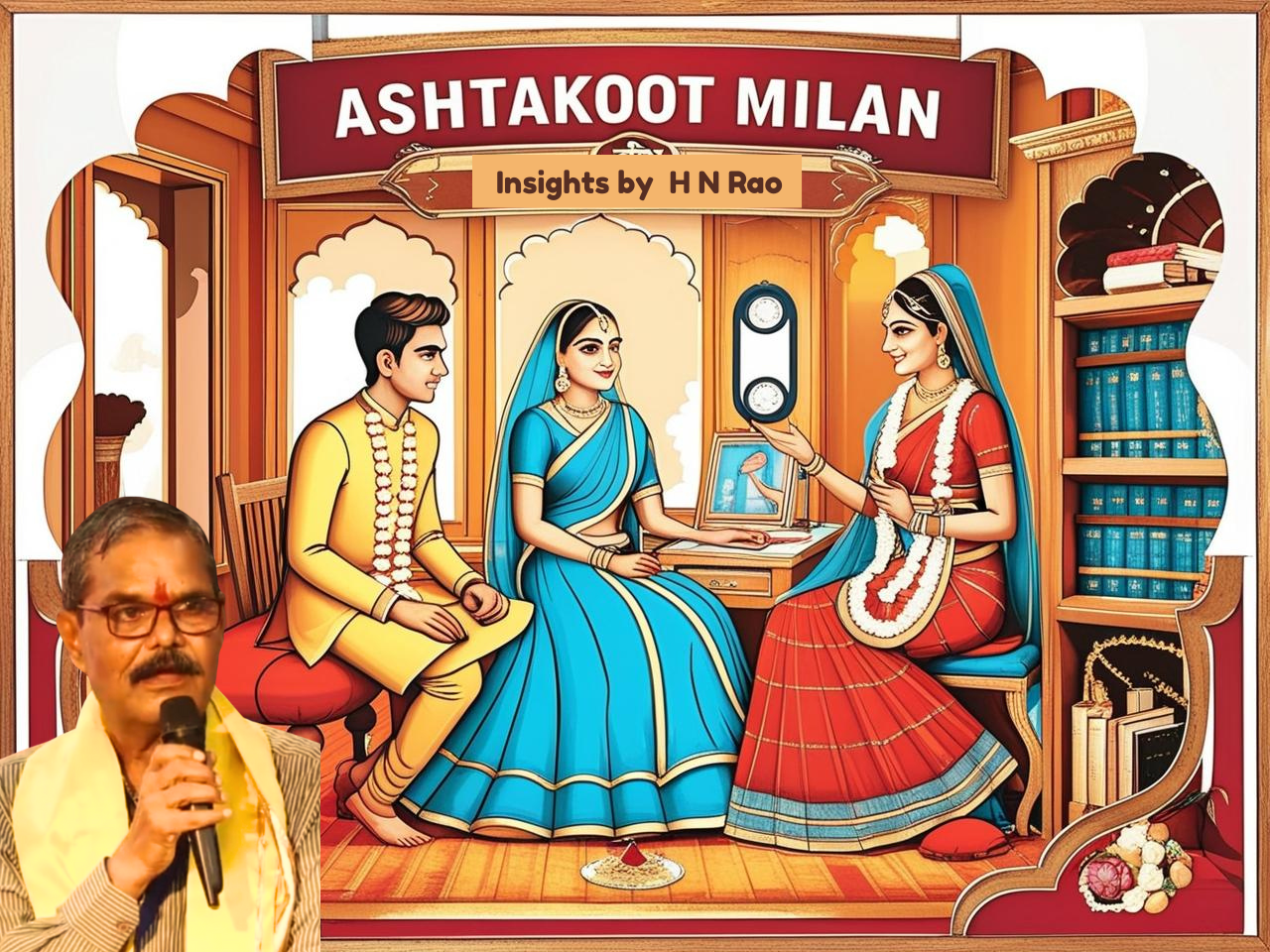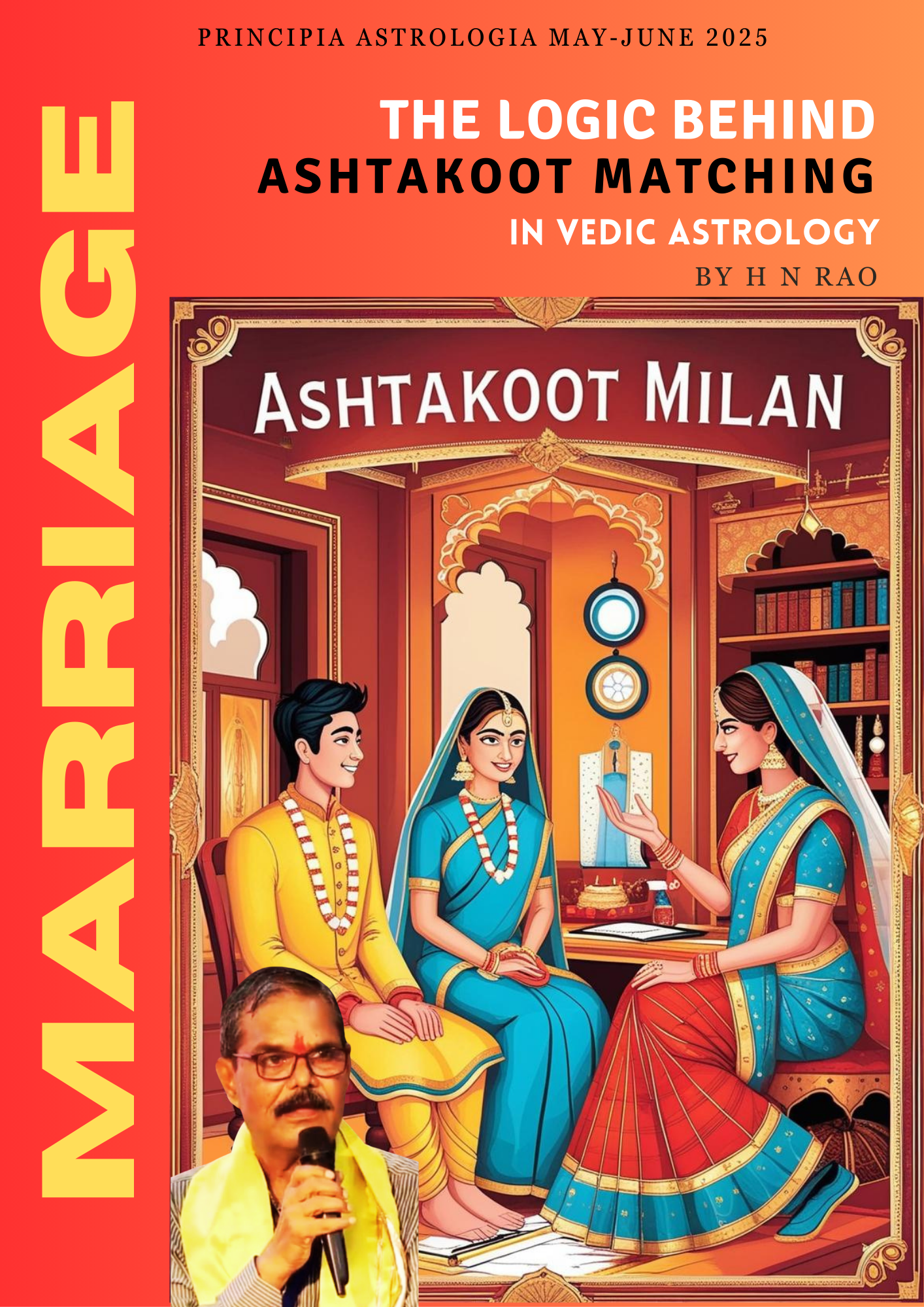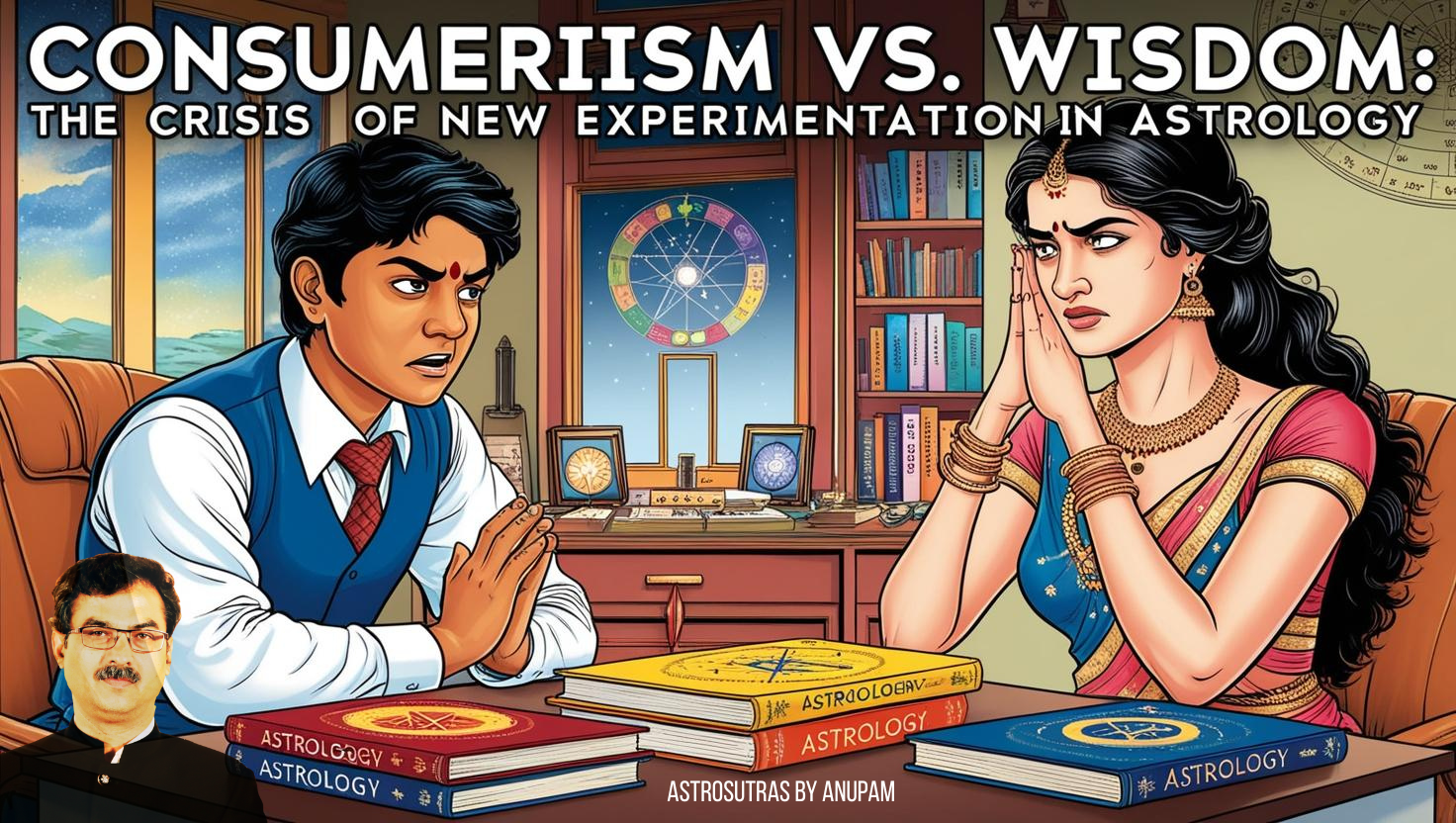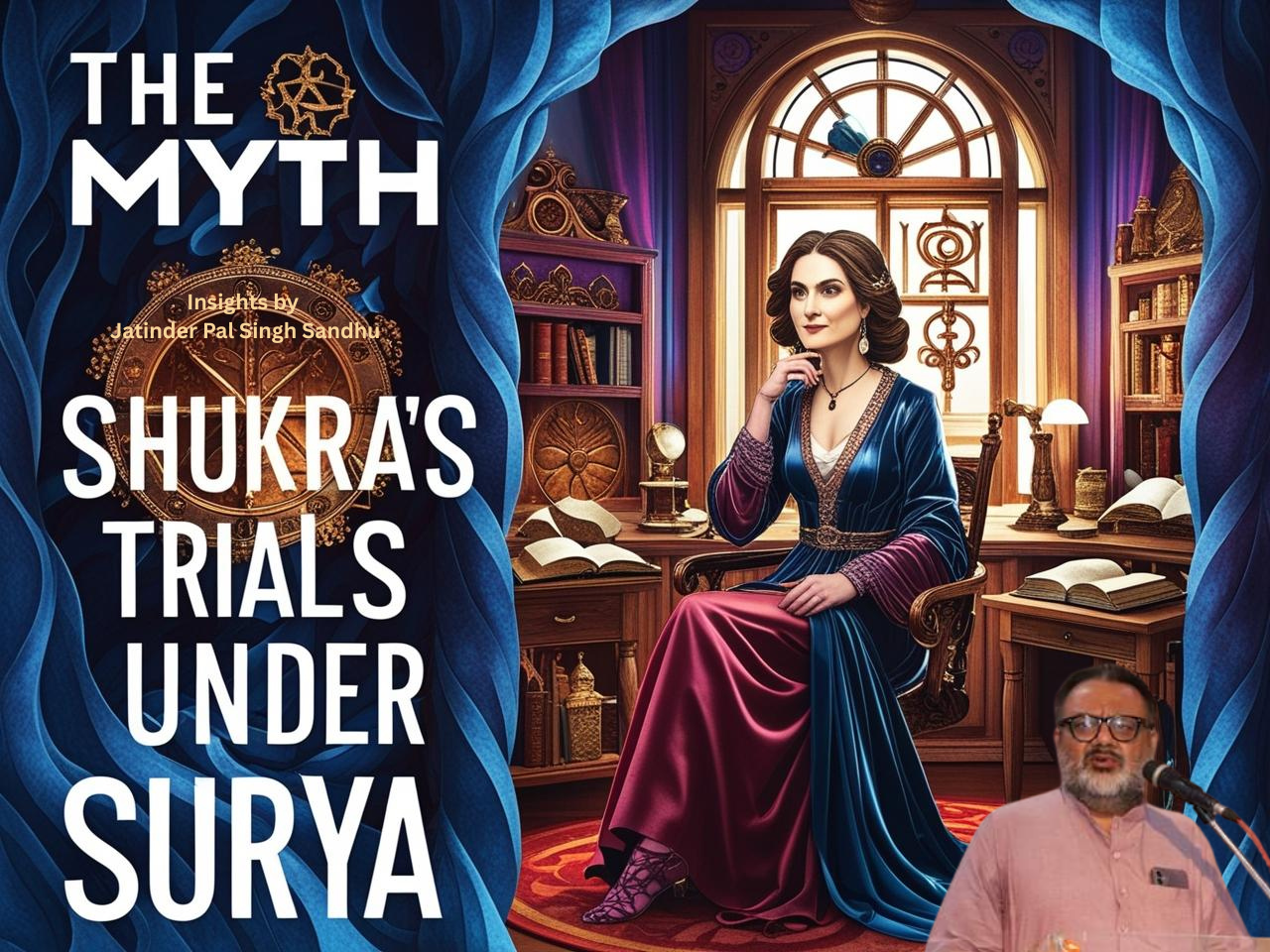The Logic Behind Ashtakoot Matching in Vedic Astrology

Why Ashtakoot Matching?
Marriage marks the entry into household life, which forms the foundational basis of human life. To understand the behavior, thoughts, qualities, and tendencies of a prospective life partner, the sages devised a simple, accessible, and practical method known as Ashtakoot Milan.
Ashta means eight, and Koot means secrets or aspects—thus, Ashtakoot refers to the comparative assessment of eight aspects of compatibility.
Why Is It Necessary?
Marriage is one of the most significant sacraments in human life. In Hindu Vedic culture, matching the birth charts before marriage is a classical tradition. It is essential to match the horoscopes of the prospective couple beforehand so that they may lead a smooth and harmonious married life.
Many people, while fixing a marriage, are satisfied with just a superficial Guna (score-based) matching, but complete horoscope matching is much more comprehensive. Ignoring this can result in significant challenges in the marital journey.
To assess compatibility in marriage, our sages wrote many texts—like the Samhitas of Vashishtha, Narada, Garga, as well as treatises like Muhurtamartanda, Muhurtachintamani, etc.—among which Ashtakoot Matching is the most prevalent. Here’s what each of the eight koots assesses:
- Varna Koot – Work potential, mental inclination, personality, nature.
- Vashya Koot – Control, emotional harmony, attraction, dominance.
- Tara Koot – Compatibility in understanding, fortune, mutual prosperity or separation in married life.
- Yoni Koot – Mindset, temperament, sexual compatibility and satisfaction.
- Graha Maitri Koot – Intellectual level, health, mutual trust and cooperation, friendship or enmity.
- Gana Koot – Taste and preferences, relationship with family, nature’s harmony, dominance of innate qualities.
- Bhakoot Koot – Daily life harmony, sweetness in the relationship, mutual exchange, love.
- Nadi Koot – Stability in married life, similarity in doshas (Vata, Pitta, Kapha), compatibility in progeny and health.
These eight koots help identify eight types of potential flaws or doshas, and their remediation.
Other Critical Factors (Beyond Gunas):
In addition to Ashtakoot matching, the following factors must also be examined in both charts because, despite high Guna scores, disagreements or separations are still observed when these are ignored:
- Pitru Dosha (ancestral affliction)
- Strength of fortune (Bhagya Bala)
- Poverty-indicating combinations (Daridra Yoga)
- Dasha overlaps
- Divorce Yogas
- Longevity (Ayushya)
- Kaal Sarp Dosha
- Multiple marriage yogas (Dwi-Bharya Yoga)
- Progeny-related combinations
- Ascendant and house compatibility
- Widowhood/Widower yogas
- Impotency combinations
- Misfortune, accidents, or health-related yogas
- Age difference between bride and groom
- Friendship between the Navamsa lords of their Moon signs
Also consider:
- Character defects, addictions, infidelity-related yogas, which can lead to marital discord or separation.
Mahanakshatras (Great Nakshatras):
There are 8 nakshatras considered especially auspicious:
Rohini, Ardra, Magha, Hasta, Vishakha, Shravan, Uttarabhadrapada, and Revati.
If both partners are born in these, the match is considered highly favorable.
- Relationship with in-laws
- Mangal Dosha from Ascendant and Moon:
If Mangal dosha is present in one chart and not in the other, it may lead to quarrels, separation, or marital problems. However, there are several exceptions to Mangal Dosha, which can nullify its effects.
Additional Principles in South Indian Astrology:
- Mangal in the 2nd house
- Rajju Koot – Indicates the duration of married life.
- Mahendra Koot – Denotes enhancement of fortune through children, growth, longevity, love, peace in the family.
- Stree Deergha Koot – Signifies prosperity, wealth, general well-being.
- Vedha Koot – Certain nakshatra pairings are considered prohibited.
- Elemental friendship between Nakshatras
- Gender classification of Nakshatras
- Varga Koot – Based on categories like enemy, neutral, friend.
- Jaimini School considers Upapada Lagna for analysis.
Conclusion:
Nowadays, Ashtakoot matching can be done through computer software, but given its profound importance, the final judgment should always be made by a qualified and experienced astrologer.

श्री गणेशाय नमः
अष्टकूट मिलान क्यों?
विवाह मानव जीवन में गृहस्थ जीवन में प्रवेश का संकेत है, जो जीवन का मूल आधार बनता है। भावी जीवन साथी का व्यवहार, सोच, गुण एवं प्रवृत्तियों को समझने के लिए हमारे ऋषियों ने एक सरल, सहज एवं व्यावहारिक विधि की रचना की, जिसे अष्टकूट मिलान कहा जाता है।
अष्ट का अर्थ है आठ, और कूट का अर्थ है रहस्य या पहलू — अर्थात अष्टकूट मिलान आठ प्रकार की अनुकूलताओं की तुलनात्मक समीक्षा है।
यह आवश्यक क्यों है?
विवाह मानव जीवन के सबसे महत्वपूर्ण संस्कारों में से एक है। हिंदू वैदिक संस्कृति में विवाह से पूर्व कुंडली मिलान की परंपरा अत्यंत प्राचीन है। भावी दंपत्ति की कुंडलियाँ मिलाना आवश्यक होता है ताकि उनका दांपत्य जीवन सौहार्दपूर्ण और सुगम हो सके।
अक्सर देखा जाता है कि लोग केवल गुण मिलान (गुणांक आधारित मिलान) पर ही संतुष्ट हो जाते हैं, जबकि पूरा कुंडली मिलान कहीं अधिक व्यापक और आवश्यक होता है। इस उपेक्षा के कारण दांपत्य जीवन में आगे चलकर कई तरह की समस्याएं उत्पन्न हो सकती हैं।
विवाह-संबंधों की अनुकूलता के मूल्यांकन के लिए हमारे ऋषियों ने कई ग्रंथों की रचना की — जैसे वशिष्ठ, नारद, गर्ग की संहिताएँ तथा मुहूर्तमार्तण्ड, मुहूर्तचिंतामणि आदि — जिनमें अष्टकूट मिलान सबसे अधिक प्रचलित है। ये आठ कूट निम्नलिखित हैं:
- वर्ण कूट – कार्यक्षमता, मानसिक प्रवृत्ति, व्यक्तित्व, स्वभाव।
- वश्य कूट – नियंत्रण, भावनात्मक सामंजस्य, आकर्षण, प्रधानता।
- तारा कूट – समझने की प्रवृत्ति, भाग्य, परस्पर समृद्धि या वैवाहिक जीवन में अलगाव।
- योनि कूट – मानसिकता, स्वभाव, यौन अनुकूलता एवं संतुष्टि।
- ग्रह मैत्री कूट – बौद्धिक स्तर, स्वास्थ्य, परस्पर विश्वास, सहयोग, मित्रता या शत्रुता।
- गण कूट – रुचियाँ, कुटुंब संबंध, स्वभाव की एकरूपता, गुणों की प्रधानता।
- भकूट कूट – दैनिक जीवन में सामंजस्य, प्रेम, लेन-देन में मिठास।
- नाड़ी कूट – दांपत्य जीवन में स्थिरता, त्रिदोष (वात, पित्त, कफ) की समानता, संतान योग एवं स्वास्थ्य।
इन आठ कूटों से आठ प्रकार के संभावित दोषों की पहचान और उनके समाधान का मार्ग ज्ञात होता है।
अन्य आवश्यक बातें (गुणों के अतिरिक्त):
अष्टकूट मिलान के साथ-साथ निम्नलिखित विषयों का भी अवश्य परीक्षण किया जाना चाहिए, क्योंकि केवल अधिक गुणों की उपस्थिति के बावजूद, अगर ये पहलू उपेक्षित रह जाएं तो वैवाहिक जीवन में मतभेद या अलगाव की संभावना बनी रहती है:
- पितृ दोष
- भाग्य बल (भाग्य की मजबूती)
- दारिद्र योग
- दशाओं का परस्पर प्रभाव (दशान्तार्दशा)
- तलाक योग
- आयुष्य (जीवन अवधि)
- कालसर्प दोष
- द्विभार्या योग (एक से अधिक विवाह का संकेत)
- संतान सुख से जुड़े योग
- लग्न और भावों का आपसी सामंजस्य
- वैधव्य / विधुर योग
- नपुंसक योग
- अरिष्ट, दुर्घटना या रोग के योग
- वर-वधु के बीच आयु का अंतर
- चंद्र राशि के नवांश स्वामियों की आपसी मैत्री
इन बातों पर भी विचार आवश्यक है:
- चरित्र दोष योग, व्यसन योग, व्यभिचार योग, जो गृहक्लेश या अलगाव का कारण बन सकते हैं।
महानक्षत्र:
आठ नक्षत्रों को विशेष शुभ माना गया है:
रोहिणी, आर्द्रा, मघा, हस्त, विशाखा, श्रवण, उत्तर भाद्रपद और रेवती।
यदि वर और कन्या का जन्म इन नक्षत्रों में हुआ हो तो यह मिलान अत्यंत शुभफलदायक माना जाता है।
- सास-ससुर से संबंधों का विचार भी किया जाता है।
लग्न और चंद्र से मंगल दोष:
यदि एक की कुंडली में मंगल दोष हो और दूसरे की कुंडली में न हो, तो यह पति-पत्नी के बीच झगड़ों, कलह, और अलगाव का कारण बन सकता है।
हालांकि, मंगल दोष के कई अपवाद भी हैं, जो इस दोष को समाप्त कर सकते हैं।
दक्षिण भारतीय ज्योतिष में विशिष्ट सूत्र:
- द्वितीय भाव में मंगल की उपस्थिति
- रज्जू कूट – वैवाहिक जीवन की अवधि दर्शाता है
- महेन्द्र कूट – संतान से भाग्यवृद्धि, उन्नति, आयु, प्रेम व पारिवारिक सुख-शांति
- स्त्री दीर्घ कूट – समृद्धि, धन-संपत्ति और सामान्य शुभता
- वेध कूट – कुछ नक्षत्रों का मेल वर्जित माना गया है
- नक्षत्र तत्व मैत्री
- नक्षत्रों का लिंग विचार
- वर्ग कूट – शत्रु, सम या मित्र वर्ग पर आधारित
- जैमिनी सिद्धांत – उपपद लग्न से विचार
निष्कर्ष:
आज के समय में अष्टकूट मिलान कंप्यूटर सॉफ्टवेयर से आसानी से किया जा सकता है,
लेकिन यह विषय इतना गंभीर और महत्वपूर्ण है कि इसका विवेचन और अंतिम निर्णय किसी योग्य एवं अनुभवी ज्योतिषाचार्य द्वारा ही किया जाना चाहिए।


